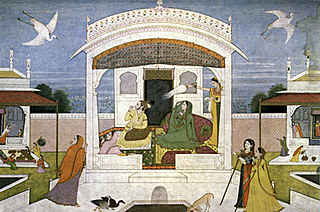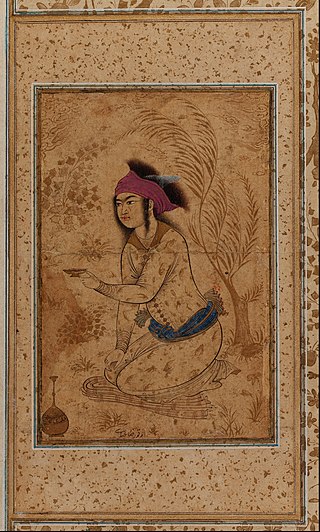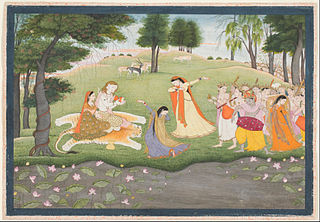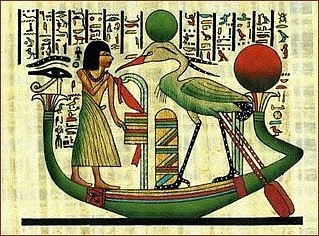Related Research Articles

Printmaking is the process of creating artworks by printing, normally on paper, but also on fabric, wood, metal, and other surfaces. "Traditional printmaking" normally covers only the process of creating prints using a hand processed technique, rather than a photographic reproduction of a visual artwork which would be printed using an electronic machine ; however, there is some cross-over between traditional and digital printmaking, including risograph.

Gouache, body color, or opaque watercolor is a water-medium paint consisting of natural pigment, water, a binding agent, and sometimes additional inert material. Gouache is designed to be opaque. Gouache has a long history, having been used for at least twelve centuries. It is used most consistently by commercial artists for posters, illustrations, comics, and other design work.

Watercolor or watercolour, also aquarelle, is a painting method in which the paints are made of pigments suspended in a water-based solution. Watercolor refers to both the medium and the resulting artwork. Aquarelles painted with water-soluble colored ink instead of modern water colors are called aquarellum atramento by experts. However, this term has now tended to pass out of use.
Sizing or size is a substance that is applied to, or incorporated into, other materials—especially papers and textiles—to act as a protective filler or glaze. Sizing is used in papermaking and textile manufacturing to change the absorption and wear characteristics of those materials.

Paper marbling is a method of aqueous surface design, which can produce patterns similar to smooth marble or other kinds of stone. The patterns are the result of color floated on either plain water or a viscous solution known as size, and then carefully transferred to an absorbent surface, such as paper or fabric. Through several centuries, people have applied marbled materials to a variety of surfaces. It is often employed as a writing surface for calligraphy, and especially book covers and endpapers in bookbinding and stationery. Part of its appeal is that each print is a unique monotype.

A miniature is a small illustration used to decorate an ancient or medieval illuminated manuscript; the simple illustrations of the early codices having been miniated or delineated with that pigment. The generally small scale of such medieval pictures has led to etymological confusion with minuteness and to its application to small paintings, especially portrait miniatures, which did however grow from the same tradition and at least initially used similar techniques.

The Freer Gallery of Art is an art museum of the Smithsonian Institution in Washington, D.C. focusing on Asian art. The Freer and the Arthur M. Sackler Gallery together form the National Museum of Asian Art in the United States. The Freer and Sackler galleries house the largest Asian art research library in the country and contain art from East Asia, South Asia, Southeast Asia, the Islamic world, the ancient Near East, and ancient Egypt, as well as a significant collection of American art.

Indian art consists of a variety of art forms, including painting, sculpture, pottery, and textile arts such as woven silk. Geographically, it spans the entire Indian subcontinent, including what is now India, Pakistan, Bangladesh, Sri Lanka, Nepal, and at times eastern Afghanistan. A strong sense of design is characteristic of Indian art and can be observed in its modern and traditional forms.

Mughal painting is a style of painting on paper confined to miniatures either as book illustrations or as single works to be kept in albums (muraqqa), from the territory of the Mughal Empire in South Asia. It emerged from Persian miniature painting and developed in the court of the Mughal Empire of the 16th to 18th centuries. Battles, legendary stories, hunting scenes, wildlife, royal life, mythology, as well as other subjects have all been frequently depicted in paintings.

Indian painting has a very long tradition and history in Indian art, though because of the climatic conditions very few early examples survive. The earliest Indian paintings were the rock paintings of prehistoric times, such as the petroglyphs found in places like the Bhimbetka rock shelters. Some of the Stone Age rock paintings found among the Bhimbetka rock shelters are approximately 10,000 years old.

Pahari painting is an umbrella term used for a form of Indian painting, done mostly in miniature forms, originating from the lower Himalayan hill kingdoms of North India and plains of Punjab, during the early 17th to mid 19th century, notably Basohli, Mankot, Nurpur, Chamba, Kangra, Guler, Mandi and Garhwal. Nainsukh was a famous master of the mid-18th century, followed by his family workshop for another two generations. The central theme of Pahari painting is depiction of eternal love of Hindu deities Radha and Krishna. A distinct lyricism, spontaneous rhythm, softness, minute intricate details of composition, and intense perception and portrayal of human emotions and physical features distinguish the Pahari miniatures from the other miniature schools like Deccan, Mughal and Rajasthani-Rajput.

A Persian miniature is a small Persian painting on paper, whether a book illustration or a separate work of art intended to be kept in an album of such works called a muraqqa. The techniques are broadly comparable to the Western Medieval and Byzantine traditions of miniatures in illuminated manuscripts. Although there is an equally well-established Persian tradition of wall-painting, the survival rate and state of preservation of miniatures is better, and miniatures are much the best-known form of Persian painting in the West, and many of the most important examples are in Western, or Turkish, museums. Miniature painting became a significant genre in Persian art in the 13th century, receiving Chinese influence after the Mongol conquests, and the highest point in the tradition was reached in the 15th and 16th centuries. The tradition continued, under some Western influence, after this, and has many modern exponents. The Persian miniature was the dominant influence on other Islamic miniature traditions, principally the Ottoman miniature in Turkey, and the Mughal miniature in the Indian sub-continent.

Tracing paper is paper made to have low opacity, allowing light to pass through. Its origins date back to at least the 1300s where it was used by artists of the Italian Renaissance. In the 1880s, tracing paper was produced en masse, used by architects, design engineers, and artists. Tracing paper was key in creating drawings that could be copied precisely using the diazo copy process. It then found many other uses. The original use for drawing and tracing was largely superseded by technologies that do not require diazo copying or manual copying of drawings.

Basohli is a town near Kathua in Kathua district in the union territory of Jammu and Kashmir, India. It is situated on the right bank of River Ravi at an altitude of 1876 ft. It was founded by Raja Bhupat Pal sometime in 1635. It was known for the palaces which are now in ruins and miniatures paintings. The Battle of Basoli was fought in this region.

A Muraqqa is an album in book form containing Islamic miniature paintings and specimens of Islamic calligraphy, normally from several different sources, and perhaps other matter. The album was popular among collectors in the Islamic world, and by the later 16th century became the predominant format for miniature painting in the Persian Safavid, Mughal and Ottoman empires, greatly affecting the direction taken by the painting traditions of the Persian miniature, Ottoman miniature and Mughal miniature. The album largely replaced the full-scale illustrated manuscript of classics of Persian poetry, which had been the typical vehicle for the finest miniature painters up to that time. The great cost and delay of commissioning a top-quality example of such a work essentially restricted them to the ruler and a handful of other great figures, who usually had to maintain a whole workshop of calligraphers, artists and other craftsmen, with a librarian to manage the whole process.

Government Museum and Art Gallery, Chandigarh, is a premier museum of North India having collections of Gandharan sculptures, sculptures from ancient and medieval India, Pahari and Rajasthani miniature paintings. It owes its existence to the partition of India in August, 1947. Prior to the partition, much of the collections of art objects, paintings and sculptures present here were housed in the Central Museum, Lahore, the then capital of Punjab. The museum has one of the largest collection of Gandharan artefacts in the world.

Kangra painting is the pictorial art of Kangra, named after the Kangra State, a former princely state of Himachal Pradesh, which patronized the art. It became prevalent with the fading of Basohli school of painting in mid-18th century, and soon produced such a magnitude in paintings both in content as well as volume, that the Pahari painting school, came to be known as Kangra paintings.

Painting is the practice of applying paint, pigment, color or other medium to a solid surface. The medium is commonly applied to the base with a brush, but other implements, such as knives, sponges, and airbrushes, can be used.

Watercolor paper is paper or substrate onto which an artist applies watercolor paints, pigments, or dyes. Artists generally no longer use stone or tomb walls as a substrates. Many types of watercolour papers that are manufactured for the use of watercolors are currently available. Watercolor paper can be made of wood pulp exclusively, or mixed with cotton fibers. Pure cotton watercolor paper is also used by artists, though it typically costs more than pulp-based paper. It is also available as an acid-free medium to help its preservation.

The Great Mongol Shahnameh, also known as the Demotte Shahnameh or Great Ilkhanid Shahnama, is an illustrated manuscript of the Shahnameh, the national epic of Greater Iran, probably dating to the 1330s. In its original form, which has not been recorded, it was probably planned to consist of about 280 folios with 190 illustrations, bound in two volumes, although it is thought it was never completed. It is the largest early book in the tradition of the Persian miniature, in which it is "the most magnificent manuscript of the fourteenth century", "supremely ambitious, almost awe-inspiring", and "has received almost universal acclaim for the emotional intensity, eclectic style, artistic mastery and grandeur of its illustrations".
References
- ↑ "Beyond the Page: The Miniature as Attitude in Contemporary Art from Pakistan". Pacific Asia Museum. Archived from the original on November 28, 2010.
- ↑ "The World of Pahari Miniature Painting". www.123himachal.com. Retrieved 28 May 2019.